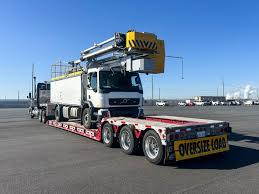Essentials of Mining Equipment Transport: Navigating the Heavy Haulage Landscape
Transporting mining equipment is a complex task that requires a deep understanding of logistics, safety regulations, and specialised equipment. As the mining industry continues to expand globally, the need for efficient and reliable mining equipment transport becomes increasingly crucial. This article explores the essential factors and considerations that stakeholders in the mining sector must address to navigate the heavy haulage landscape effectively.
Understanding the Scale of Mining Equipment
Mining operations rely on large and heavy machinery, including excavators, dump trucks, dozers, drill rigs, and more. The sheer size and weight of these machines present unique challenges for transportation. Moreover, because mining sites are often located in remote areas with difficult access routes, it is imperative to plan meticulously for successful haulage.
Planning and Route Assessment
Planning is the cornerstone of safe and successful mining equipment transport. It involves comprehensive route assessments to identify the best path for the conveyance of heavy machinery. Planners must consider road conditions, bridge load capacities, overhead clearances, and potential obstacles that could impede transport. A detailed plan ensures minimal disruption to public infrastructure and traffic.
Compliance with Regulations
In many countries, heavy haulage is subject to stringent safety standards and regulations, which are designed to protect infrastructure and public safety. Transporters must adhere to legal requirements regarding weight limits, vehicle dimensions, and permits. Failure to comply can result in costly fines, legal liabilities, and transportation delays.
Specialised Equipment for Heavy Haulage
The safe transportation of mining machinery necessitates specialised transportation equipment such as multi-axle trailers and modular configurations that can handle extreme weights and dimensions. The use of the appropriate trailers allows for the distribution of the load over a wider area, reducing the risk of road damage and improving stability during transit.
Choosing the Right Heavy Haulage Company
Selecting a reputable heavy haulage company that specialises in mining equipment transport is crucial. Experience and expertise in the field can significantly reduce risks associated with the transport of oversized machinery. A well-established haulage company will have the resources and knowledge to handle unexpected situations and mitigate potential issues.
Insurance and Liability
Transporting valuable mining equipment requires adequate insurance coverage to protect against damages incurred during haulage. Ensure that the chosen transport company offers comprehensive insurance that covers all aspects of the journey from pick-up to delivery.
Skilled Personnel
The safe transport of heavy mining equipment relies on the skills and expertise of the personnel involved. Experienced drivers, logistics coordinators, and escort vehicle operators play a critical role in ensuring the equipment arrives safely and on time. Continuous training and adherence to safety protocols are essential for reducing the risk of accidents.
Communication and Tracking
Efficient communication throughout the transport process is vital. Clear coordination between the transport team, escort vehicles, and site personnel ensures that any issues that may arise are addressed promptly. Moreover, the use of GPS tracking systems allows clients to monitor the movement of their equipment in real-time, providing peace of mind and logistical control.
Environmental Considerations
Heavy haulage can have significant environmental impacts. Conscious efforts to reduce the carbon footprint, such as optimising routes to reduce fuel consumption, are becoming more important in the industry. Eco-friendly practices can also improve a company’s reputation and contribute to sustainable mining operations.
Load Securing and Protection
Ensuring that heavy machinery is securely fastened and adequately protected for the journey is another facet of a successful transport operation. This entails using the right tie-down practices and protective coverings to prevent damage from environmental factors, such as weather, during transit.
On-site Coordination
The arrival of mining equipment marks the beginning of another critical phase: the offloading and installation process. On-site coordination of cranes, rigging teams, and other necessary resources must be prearranged to ensure seamless integration of the equipment into the mining operation.
Contingency Planning
Despite meticulous planning, heavy haulage can encounter unforeseen issues, such as bad weather, road closures, or equipment breakdowns. Having a robust contingency plan in place allows for a quick response and minimises disruptions to the delivery schedule.
Maintaining a Safety-First Approach
Throughout the entire mining equipment transport process, prioritising safety is paramount. This includes ensuring that all safety measures are observed during transit and that all personnel involved are well-informed about the potential hazards and emergency procedures.
Conclusion
In summary, the transportation of mining equipment involves intricate planning, adherence to regulations, the utilisation of specialised equipment, and extensive coordination among skilled professionals. A focus on sustainability, safety, and efficiency is essential when navigating the heavy haulage landscape. Partnerships with experienced mining equipment transport companies will continue to be indispensable for the mining industry to thrive in a competitive, global market.
Final Thoughts
By addressing each of these essentials, stakeholders in the mining industry can ensure that the formidable task of transporting heavy mining equipment is completed seamlessly, paving the way for successful mining operations and the continuous growth of the sector.
READ MORE : Discover Saida Towers: Your Ultimate Beachfront Getaway on South Padre Island

